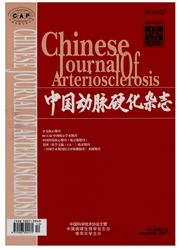

 中文摘要:
中文摘要:
目的观察小干扰RNA(siRNA)重组慢病毒介导的CREB结合蛋白(CBP)基因沉默对大鼠颈动脉球囊损伤后新生内膜增生的影响,并探讨其作用机制。方法雄性SD大鼠48只,随机分为4组:假手术组、PBS对照组、慢病毒介导CBP基因siRNA转染组(CBP—siRNA—Lenti组)及慢病毒介导非CBP同源序列siRNA转染组(NC-siRNA.Lenti组)。建立大鼠颈动脉球囊损伤模型,术后28天处死动物。分别用实时定量PCR、WesternBlot检测大鼠颈动脉CBP和乙酰化核因子KBp65(NF—κBp65)的表达水平;病理组织学观察血管内膜增生情况;免疫组织化学染色对损伤血管壁增殖细胞核抗原(PCNA)的表达进行评估。结果术后28天,与PBS对照组和NC-siRNA—Lenti组比较,CBP.siRNA—Lenti组CBPmRNA和蛋白的表达显著下调(P均〈0.05),CBP沉默能明显抑制新生内膜面积(0.108±0.008mm2比0.238±0.022mm2、0.252±0.016mm2,P〈0.05)、内膜与中膜面积比(0.706±0.062比1.483±0.136、1.497±0.137,P〈0.05)的增加,及下调血管壁乙酰化NF—κBp65和PCNA的表达水平(P均〈0.05)。结论慢病毒介导的CBP基因沉默能有效地抑制颈动脉球囊损伤后新生内膜的形成,其机制可能与抑制NF—κBp65的过度乙酰化有关。
 英文摘要:
英文摘要:
Aim To investigate the effects of siRNA recombinant lentivirus targeting CREB binding protein (CBP) gene on neointimal hyperplasia in rat carotid arteries after balloon injury and its possible mechanism. Methods Forty-eight male SD rats were randomly divided into four groups: Sham group, PBS group, CBP-siRNA-Lentivirus group and NC-siRNA-Lentivirus group to establish the model of balloon-injury in left common carotid artery, and the rats were sacrificed 28 days after injury and in vivo gene transfer. The expression of CBP and acetylated nuclear factor kappaB p65 (NF-KB p65) were determined by real-time PCR and Western Blot. Proliferating cell nuclear antigen (PCNA) protein expression was detected by immunohistochemistry. Meanwhile, morphometric analysis was used to measure neointimal hyperplasia. Results 28 days after operations, lentivirus siRNA targeting CBP markedly decreased CBP mRNA and protein expression compared with PBS and NC-siRNA-Lentivirus groups ( P 〈 0. 05 ). CBP gene silencing significantly reduced the neointimal area (0. 108±0. 008 mm2 vs 0. 238 ±0. 022 mm2 and 0. 252 ±0. 016 mm2, P 〈0. 05) and intima / media ratio (0. 706 ± 0. 062 vs 1. 483 ± 0. 136 and 1. 497 ± 0. 137, P 〈 0. 05 ). Furthermore, compared with PBS and NC-siRNA-Lentivirus groups, PCNA and acetylation of NF-κB p65 expression were both obviously downregulated in CBP-siRNA-Lentivirus group (P 〈 0. 05 ). Conclusions Lentivirus-mediated CBP gene silencing could efficiently suppress neointimal formation in balloon injured rat carotid artery, and the mechanism was involved with downregulation of NF-κB p65 acetylation.
 同期刊论文项目
同期刊论文项目
 同项目期刊论文
同项目期刊论文
 High mobility box 1 mediates neutrophil recruitment in myocardial ischemia-reperfusion injury throug
High mobility box 1 mediates neutrophil recruitment in myocardial ischemia-reperfusion injury throug The HMGB1-TLR4 axis contributes to myocardial ischemia/reperfusion injury via regulation of cardiomy
The HMGB1-TLR4 axis contributes to myocardial ischemia/reperfusion injury via regulation of cardiomy RP105 Protects Against Apoptosis in Ischemia/Reperfusion- Induced Myocardial Damage in Rats by Suppr
RP105 Protects Against Apoptosis in Ischemia/Reperfusion- Induced Myocardial Damage in Rats by Suppr Radioprotective 105 kDa protein (RP105): is a critical therapeutic target for alleviating ischemia r
Radioprotective 105 kDa protein (RP105): is a critical therapeutic target for alleviating ischemia r Resveratrol pretreatment protects rat hearts from ischemia/reperfusion injury partly via a NALP3 inf
Resveratrol pretreatment protects rat hearts from ischemia/reperfusion injury partly via a NALP3 inf RP105 protects against myocardial ischemia-reperfusion injury via suppressing TLR4 signaling pathway
RP105 protects against myocardial ischemia-reperfusion injury via suppressing TLR4 signaling pathway MicroRNA-22 targeting CBP protects against myocardial ischemia-reperfusion injury through anti-apopt
MicroRNA-22 targeting CBP protects against myocardial ischemia-reperfusion injury through anti-apopt Increased expression of RP105 decreases cardiomyocytes hypoxia/reoxygenation injury through the TLR4
Increased expression of RP105 decreases cardiomyocytes hypoxia/reoxygenation injury through the TLR4 Downregulation of CREB-binding protein expression sensitizes endothelial cells to serum-deprived apo
Downregulation of CREB-binding protein expression sensitizes endothelial cells to serum-deprived apo Lentivirus-mediated RNAi Targeting CREB Binding Protein Attenuates Neointimal Formation and Promotes
Lentivirus-mediated RNAi Targeting CREB Binding Protein Attenuates Neointimal Formation and Promotes Puerarin attenuates high-glucose-and diabetes-induced vascular smooth muscle cell proliferation by b
Puerarin attenuates high-glucose-and diabetes-induced vascular smooth muscle cell proliferation by b CBP knockdown inhibits angiotensin II-induced vascular smooth muscle cells proliferation through dow
CBP knockdown inhibits angiotensin II-induced vascular smooth muscle cells proliferation through dow Down-regulation of CREB-binding protein expression inhibits thrombin-induced proliferation of endoth
Down-regulation of CREB-binding protein expression inhibits thrombin-induced proliferation of endoth cAMP-Response-Element-Binding-Protein-Binding Protein Silencing Inhibits Thrombin-Induced Endothelia
cAMP-Response-Element-Binding-Protein-Binding Protein Silencing Inhibits Thrombin-Induced Endothelia Down-regulation of CREB-binding protein expression blocks thrombin-mediated endothelial activation b
Down-regulation of CREB-binding protein expression blocks thrombin-mediated endothelial activation b Dysregulation of CREB binding protein triggers thrombin-induced proliferation of vascular smooth mus
Dysregulation of CREB binding protein triggers thrombin-induced proliferation of vascular smooth mus Urotensin II Induces Migration of Endothelial Progenitor Cells via Activation of the RhoA/Rho Kinase
Urotensin II Induces Migration of Endothelial Progenitor Cells via Activation of the RhoA/Rho Kinase A Meta-Analysis of Randomized Clinical Trials Comparing Shorter (Less or Equal Than 6 Months) and Lo
A Meta-Analysis of Randomized Clinical Trials Comparing Shorter (Less or Equal Than 6 Months) and Lo Effect of virtual reality distraction on pain among patients with hand injury undergoing dressing ch
Effect of virtual reality distraction on pain among patients with hand injury undergoing dressing ch 期刊信息
期刊信息
